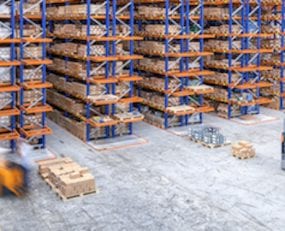
The annual results of Australian logistics property investor Goodman Group were broadly in line with expectations, but investors remain cautious, at least judging by their reaction in the immediate aftermath of its announcement, with the share price falling 1.3% from near-record highs.
The company reported higher sales than analysts had expected, yet growth for adjusted operating cash flows, operating income and adjusted net earnings was soft based on consensus estimates for the year ended June 30; which means that high-single digit growth rates for operating earnings could become harder to achieve; a fact that is also implied in Goodman’s guidance for 2018.
What forward projections also suggest is that risk might be skewed to the downside for equity holders, given the rich trading multiples currently implied by its stock valuation, although favorable dynamics and trends can be exploited by business models such as Goodman’s which are focused on owning, developing and managing industrial property and business space in key markets worldwide.
Chief executive Greg Goodman shrugged off any concern arguing that “FY17 operating profit of A$776m is the result of strong operational performance and the deliberate repositioning of our business over the last three years”, during which the group has sold over $8bn of assets in order to concentrate and redeploy “capital into large, wealthy consumer dominated markets”.
Gross revenues – which include other income before fair value adjustments on investment properties, as well as fair value adjustments on investment properties which includes share of adjustments for associates and joint ventures – fell to A$2.5bn from A$2.9bn, but the drop had to have been expected, because over the past twelve months Goodman sold A$2.3bn of assets “(excluding urban renewal), primarily in Australia, New Zealand, Japan and continental Europe, and while asset disposals will continue, the pace of sales is expected to moderate over time” with the result that net leverage hovers around more reasonable levels.
Remarkably, its financials point to a significantly lower net gearing ratio than in 2016 – it has halved from 11.8% to 5.9%, as managers have opted to go for sustainable long-term growth rather than higher short-term returns boosted by leverage.
As a side note, gearing is calculated as total interest-bearing liabilities over total assets, both net of cash and the asset component of the fair values of USD/EUR and USD/GBP cross currency interest rate swaps.
Property, management and development activities turned over A$1.14bn, up 1.5% against the prior year, with only property investment operations declining (-2.5%). However, the group managed to keep a lid on operating costs, which fell 1.7% to A$239m, yielding higher EBITDA and EBIT as well as stronger operating earnings per share, up 7.4% for the year (based on a slightly lower share count).
Cash and equivalents, meanwhile, rose to almost A$2.1bn from A$1.3bn one year earlier, surging to over A$3bn once available credit lines are considered.
Its average debt maturity profile is 3.7 years, against 4.4 years in 2016, and it expects to deliver A$828m of operating profit and “operating EPS of 45.7 cents (up 6% on FY17)” in 2018.
Source: Transport Intelligence, August 22, 2017
Author: Alessandro Pasetti